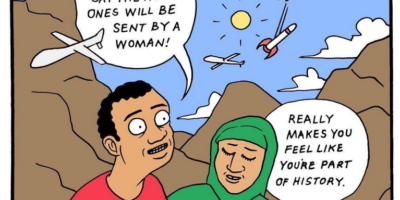By Michael Benton
“Far from being mindless, violence is usually the cutting edge of ideas and ideologies.”
—John Fraser, in Violence in the Arts (1974: 162)
I believe that violence is a necessary part of many creative narratives because it is a part of reality. Violence is a part of the human experience. How can we ignore it?
At the same time, I reject simplistic, cartoonish uses of violence where the heroes are shot at a hundred times, receiving perhaps a scratch, while methodically dispatching every person they face. I think it is irresponsible to repeatedly portray, or think of, violence as simply mindless entertainment.
It is important that we have intelligent, complex explorations of individual and collective violence. In life, there are outbreaks of violence that, when they happen, seem beyond our kin or present understanding. But, usually with time, we are able to grasp their motivations or causes. Likewise, in a work of “art,” one can begin to grasp at the reason for the violence and make a sort of sense of it, even if one does not agree with the portrayal of the causes or motivations for the violence.
What is needed is intelligent reflection on the uses or outbreaks of violence. Is it a means to a goal? Is it a frustrated reaction to events beyond our control? A tool for oppression/resistance. Who is using the violence? As a means to what end? Who is/are the victim/s? Why are they chosen? Is the violence random? What are the goals of the perpetrator?
Ultimately, violence in great films cause you to think about the action beyond the visceral sensations. It challenges you to exercise your own judgment, to initiate critical reflection upon the events of the story. For me, this is a defining moment in judging a film or any other work of art.
Narrative violence
The benefit of some narrative violence is that it makes it harder for audiences to ignore the motivations or beliefs of the characters. This is especially true when we become implicated by our own violent impulses, becoming so wrapped up in the narrative that we encourage the violence—”Do it! Do it!” A good narrative can cause us to reflect on this dangerous impulse. Thus, in the complex cinematic presentation, we are faced with an intellectual quandary in regard to the usage of the violence and the rationale for its usage.
A powerful film will not allow us to stand on the sidelines and retain our intellectual integrity. We have to take a stand, even if it is to condemn the movie. After all, the artist presents us with a work that is intended to shock or affront. (This cuts both ways: it is also hypocritical for the artist to complain when people condemn their work if their intent was to depict acts of violence in a graphic manner.)
Violence historically is employed in the service of power on an individual or systemic level. Our democracy is built on the ignorance of the daily usage of violence to keep some people docile about their situation in life. This structural mask sometimes slips, allowing a glimpse of the true face of that power. Thus, a necessary part of some violent narratives is our understanding of the roots of hegemonic power. Most Hollywood films, as well as many foreign films (see the recent explosion of Asian extreme films), miss this aspect of violence. People facing the threat of actual acts of violence help us to understand human potential. It is not a case of human physicality or oversized phallic weapons. It is an examination of the operations of power in society.
Some violent films to view
Pier Paolo Pasolini’s brutal, disgusting and difficult Salo, or the 120 Days of Sodom (Italy: 1975) traumatically (for this viewer) explores the victim’s complicity as well as the oppressor’s degradations in fascist societies. It is a truly painful and wrenching film, but I do not regret having watched it.
The ending of Peter Greenaway’s aesthetically beautiful The Baby of Macon (UK: 1993) horrified me more than any sophomoric slasher story ever could and, to this day, has left me pondering the meaning of the film. Blocked from being exhibited in the U.S., when we showed it for our film society at Illinois State University, people were crying in the audience. Afterwards, we spilled into the streets and made our way to a pub where we argued into the night about the meanings of the film. As with any difficult film, some of the audience members were angry that we had shown it, and they had reason to be angry. We listened patiently to their complaints even if we believed, ultimately, that the film should be seen.
If you believe that a disturbing portrayal is important and should be seen, you should respect contrary, disturbed and angry reactions. This is what you expected the film to do, therefore you should address its effects on those audiences. Do not dismiss these humanistic responses, engage in a dialogue that art demands of its audiences. Do not become complicit in the further mystification of experience. Directly engage with audience members’ fear/confusion and, in the process, your own.
A problem with the usage of violence in contemporary film is that it has become an effect used to entertain and titillate. This is the ultimate failing of a filmmaker like Quentin Tarantino. He so desperately wants to be understood as a serious filmmaker, while also doing everything he can to be one of the cool kids. In order to remain popular, his films do little to understand the violence that is liberally spread around like party favors.
A critic of these types of films produced one of the most powerful and disturbing films of the last few years. Michael Haneke’s Cache (France/Austria: 2005) explores the after effects of repressed systemic and individual acts of aggression/violence. It is minimalist and subtle in its presentation of violence, but the impact is long-lasting, reverberating in my mind still, causing me to question the impact of individual and societal repression of violent histories. It forces us to reflect on our own societal repression of historical violence and our individual role in this repression. Perhaps even more devastating is the subtle portrayal of the long-lasting, generational effects of violence.
Instances of violence can also cause us to focus on what gives life dignity and what is noble and ignoble in the human condition. The legendary Senegalese filmmaker Ousmane Sembène’s last film, Moolaadé (Burkina Faso/Senegal: 2004), demonstrates how cinematic art has the potential to change the world. Its portrayal of structural and individual violence speaks to audiences around the world. In protagonist Collè’s struggle to speak out and stand up against tradition-bound violence, it presents an imaginative opportunity for the audience to consider its own society and its stance within it.
The violence of war
A recent BBC/HBO film, Conspiracy (UK/USA: Kenneth Branagh, 2001), has led me to consider how problematic the violence of war is when represented in films. Any representation of the actual battles of warfare, even in explicitly anti-war films, becomes an opportunity for people to glorify the heroics of the participants. Former marine Anthony Swofford, in his memoir Jarhead (2003), called these films “War Porn” because they were used to pump up new recruits for the Gulf War. They didn’t watch nationalistic celebrations of war as good, like John Wayne’s Green Berets (USA: 1968). Instead, they screened traditional anti-war films like Apocalypse Now (USA: 1979) and Full Metal Jacket (USA: 1987).
This is where Conspiracy is different from other war films. It delves into the inner world of power kept hidden in traditional narratives. It goes into the legal process of the 1942 Wannsee Conference in which NAZI military and officials negotiated the “Final Solution” for the perceived problem of the Jews. The film powerfully engages us in the use of pens and words as weapons against peoples. At the same time, for me, it provokes a consideration of our own current legal minds that institute “torture memos,” “secret prison camps,” “extraordinary renditions,” and “assassination policies.” This is violence perpetrated on a massive scale.
A last thought. Legitimated violence—sanctioned by the state, or other social forces–usually is a clear indicator of the boundaries of society: what is permitted, what is forbidden, and who controls these boundaries. Always reflect on what those boundaries are, who they benefit and who suffers, and how they are masked/legitimated as normal.



Leave a Reply